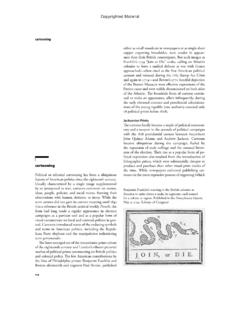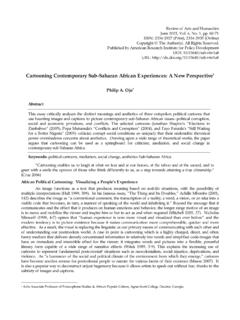Transcription of THE ART OF EDITORIAL CARTOONING - Adam Zyglis
1 1 My constituents can t read. But damn it, they can see pictures. -William M. TweedTHE ART OF EDITORIAL CARTOONINGAdam ZyglisSenior Honors ThesisDecember 4, 2003 Canisius College, Buffalo, NYAdvisor: Thomas JoyceEnglish DepartmentCanisius College, Buffalo, NYSecond Reader: Mel ShroederEnglish DepartmentCanisius College, Buffalo, ..4 PART I CREATING A CONTEXT: Definitions & is Art? ..6 Mimetic is the EDITORIAL Cartoon? ..12 Are EDITORIAL Cartoons Art? ..16 PART II THE EDITORIAL CARTOON: Past & Brief, Highly Subjective Look Around the Clay III AN ARTIST S PERSPECTIVE: The IV THE EDITORIAL CARTOON: Art & Mark of Journalism Art Art Art V FINAL A CARTOON GALLERIES ..59A Highly Subjective Historical Highly Subjective Contemporary Personal B FULL LENGTH July 22nd 1987, Palestinian political cartoonist Naji al-Ali was assassinatedseveral feet from the newspaper office he worked at in London.
2 The thousands of hiscartoons that exposed the dirty politics of the Middle East had cost him his life. It is evenargued that one of his last cartoons was solely responsible for his death( ). Even though the possibility of being assassinated is not a seriousconcern of cartoonists in the United States, this martyr of patriotic art certainlyilluminates the potency of the American EDITORIAL cartoon. The source of this power canbe in the nature of the art form. It is an expression of yourself in every way, your politics, your aesthetics andyour personality. - Clay Bennett (Christian Science Monitor) on EDITORIAL cartooningThere are few disciplines that encompass as many genres of human activity asdoes the EDITORIAL cartoon. Its unique place in American culture has been relativelydifficult to articulate successfully. The EDITORIAL cartoon ties together art, journalism,entertainment, politics, and humor.
3 It is generally agreed upon that art and journalism arethe two prominent dimensions of its essence. However, throughout history, the art formhas been strictly labeled as a form of journalism. For instance, the most prestigiousnational award for EDITORIAL cartoonists is the Pulitzer Prize, which is a journalism , historians are the ones who have classified the cartoons in such a way, but, for5various reasons, even some cartoonists themselves consider their work primaryjournalistic in is a huge misconception. In my thesis, I will argue that EDITORIAL cartooningis primarily an art form, and the graphic art and conceptual art within the cartooningprocess are the dominant dimensions in the discipline. Furthermore, the role andimportance of this dimension is overlooked and under appreciated. Understanding thisrich mixture of elements provides a greater insight into the power and success of theeditorial support this argument I have broken my thesis into five major sections.
4 Thefirst section develops a theoretical foundation of art. This broad discussion of art isneeded as a context in which to define the EDITORIAL cartoon. Once these preliminarydistinctions are made, EDITORIAL cartoons can be seen as works of look at the progression of the discipline is the next logical step in understandingits nature. So, the second section is an examination of the past and present of the editorialcartoon. I utilize this perspective in order to identify how the art in the discipline hasdeveloped over the history of EDITORIAL CARTOONING has been analyzed, the next place to lookis in the minds of the artists themselves. Section three focuses on this perspective, andchallenges the arguments that are provided by the , the roles of art and journalism, which are the two most prominentdimensions, can be thoroughly assessed. I will begin this part with a discussion ofelements of a successful EDITORIAL cartoon.
5 Then, after exploring the roles of art and6journalism, I will show that conceptual and graphic art is dominant over journalism,making the discipline truly an art , the last section is a reflection on the unique theory of EDITORIAL cartooningthat is developed through the arguments of this thesis. Here, I will discuss theshortcomings of this theory and highlight areas of future I CREATING A CONTEXT: Definitions & DistinctionsThere are many issues involved in the process of analyzing the role of art ineditorial cartoons. One must first ask the question what is art? before identifying artwithin a specific discipline. However, this question has been proven to be extremelydifficult to answer consistently. The definition of art has changed throughout history, andit seems to become less and less definable as more and more people attempt to articulateit. So it would be both unnecessary and problematic for me to develop my own definitionof the purposes of this thesis, I will simply provide several widely accepteddefinitions, or theories, of art.
6 Several issues come into play with distinguishing art fromnon-art. How a work of art looks, what it communicates, and how it makes the viewerfeel, are all important in defining art. Finally, a definition of EDITORIAL CARTOONING can bemade within this context. From this point, it will be apparent that each widely accepteddefinition of art applies to a specific element of EDITORIAL is Art?Philosophers have debated for hundreds of years on the topic of art. Over theyears, one thing that has been agreed upon is the fact that a work of art is a type ofartifact. This is the broadest way in which art is distinguished from non-art. An artifactis anything made or created by a human being (Fisher, 148). Under this distinction,laws, theories, furniture, paintings, poems and EDITORIAL cartoons are all examples of , other human constructs such as laws fit the definition of artifacts , and mostpeople agree that laws are not artworks.
7 Thus, a more explicit distinction is is also one other universal distinction pertaining to art. It is accepted thatart consists of both content and form (Butcher, 10). The form of a work of art isultimately the way it looks . The content, in contrast, is what the artwork says . Thesetwo dimensions have been at the heart of traditional debates involving art s importance and function of both form and content are usually the determining factorsin establishing a definition of art. One of the more historically popular ongoing debateson the definition of art addresses which of these two dimensions of art is most extensive writings and studies on the subject of art have yielded four prominenttheories that can be illustrated in specific art oldest classification of art is undoubtedly found in the mimetic theory. Theword mimetic comes from mimesis, which means imitation.
8 This is simply the idea thatart is a representation, or imitation, of reality. The theory stems all the way back to thewritings of Plato and Aristotle, and it has originally developed from the ancient art ofprehistoric cave painting. In visual art, it is the pictorial representation of what an artist8sees. In literary art, it is the imitation of life through characters and stories that the writerobserves. Aristotle wrote that imitation is a universal human characteristic, making thisdefinition historically successful (Fisher, 196). Overall, the theory does not emphasizeeither form or content because both are needed in order to imitate are shortcomings to this theory, because most of the art produced today isnonrepresentational. During the Renaissance, the theory was solely applied to therepresentational art of realism, which is visual art that appears photo-realistic.
9 However,visual realism is an extremely narrow view of art by today s standards because many artmovements challenged the theory. Throughout the twentieth century, the Surrealistsquestioned the very idea of the reality portrayed by Renaissance artists, and they provideda more accurate representation of the subconscious. So now, some consider the mimetictheory to allow for explorations within this subconscious reality (Fisher, 200).Furthermore, the theory has been more recently developed to accept the imitations ofemotions and feelings, as long as these expressions represent reality. Thus, acontemporary definition of the theory qualifies an artifact to be a work of art if itaccurately represents some dimension of life at the time of the artist (Welish, 50).The next two traditional theories of art embody the form vs. content debate thatwas mentioned earlier. One side of the debate is that the content of art is most will refer to this theory as the content theory.
10 Recall that the content is what theartwork says, so this is considered to be more important than how the artwork looks. Butthat doesn t provide a definition of the late 19th century, Leo Tolstoy developed many extensive essays exploringthe definition of art. He articulated the content theory s distinction between art and non-9art. He said for art to be art [for the content theory], it is necessary that its contentshould be of something important, necessary to man, good, moral, and instructive (Welish, 38). According to this theory, a work of art is a social, moral, or political truthdressed in artistic form. Keep in mind, the form is less important but still necessary. Thetheory is not illustrated through a particular movement, but it can be seen throughout thehistory of art. For example, in 1545 during Luther s revolt against the Catholic Church,he had the artist Lucas Cranach create a series of colored woodcuts on the origin of thePope.









